#this is a game series of pyrrhic victories
Explore tagged Tumblr posts
Photo


how it started vs. how it’s going
#Saints Row#saints row1#started out bad#ended up even worse somehow!#this is a game series of pyrrhic victories#it's eye for an eye 'till the whole world's blind#but if i've got one bloody eyeball at the end of it i still win!#somehow!#the 3rd street saints mentality#i haven't slept well the past couple days i've just been rotating these games in my mind#boss mira
19 notes
·
View notes
Text
I am so looking forward to SotR basically being a Pyrrhic Victory Narrative.

#with Haymitch now being the confirmed protagonist#of course this is just one interpretation/possible way of viewing the story#BUT it’s so fitting#you could argue a lot of the series can fit into this concept#such is war in general but within THG universe#sunrise on the reaping#haymitch abernathy#he literally loses everything and is condemned to a life of misery#he wins the games but at what cost?#I am still choosing to view SotR with excitement (at least rn…it fluctuates often)#and I really am trying to look forward to the expansion of Haymitch’s story#AND THIS!! this right here#pyrrhic victory ftw#pyrrhic victory#sotr#thg
29 notes
·
View notes
Note
Ask game: Endeavor dies in his fight against the High-End Nomu.
It wasn't the Hood Noumu that killed him. Dabi succeeded in revealing his identity as Touya and finished Endeavor off before Miruko could get through the fire and stop him. Dabi's body can't handle the heat he used to kill Endeavor, though, and it finally gives out on him. The battle ends with no winners.
Without Dabi, Hawks' infiltration of the League hits a bit of a snag as he has to contact someone else now.
The MLA vs League battle goes much worse for both sides, as without Dabi, Geten is free to fuck up the battlefield and the League have no ranged options. Decay can counter Geten, but the ranged area denial means that when the battle ends, there's barely anyone left of the MLA. Re-Destro dies. The PLF never forms.
Hawks is able to alert the Heroes of Garaki's lair as without the PLF the League can't monitor his communications super well. Shigaraki never receives All For One
On the flip side, the reveal of Dabi's identity and death of the new Number One Hero, who was only Number One for one day before dying, has left society shaken. The HPSC is doing its best to crack down, but public faith in Heroes is close to nil.
70 notes
·
View notes
Note
Hey i'm sorry for reasking, last time my ask was too specific, so I hope it's not a problem if I ask again!
I'm looking for stories that have a really possessive tom who changes his plans in the end because of hermione.
I hope this time it isn't too specific, thanks!
Hi Anon:
Are you the anon asking for fics like Midgardsommer? If so, we have some recs below for a possessive Tom with a changing plans, courtesy of the Tomione Discord- Haus
The Only Beautiful Thing in This World is You by Speechwriter
M | Complete | 58k
Everyone knows that Tom Riddle is the perfect Avatar. An effortless diplomat and prodigious bender, he’s the Fire Nation’s pride and joy. Strangely, though, Riddle has never been able to access the Avatar State. To that end, Hermione Granger—a Northern waterbending master—has been invited to the Fire Nation’s Royal Palace, in hopes that her qi-therapy techniques will unlock Riddle’s full Avatar power. No one knows that Hermione Granger is part of a society that has been tracking Riddle’s actions meticulously for years. Hermione knows full well that Riddle isn’t what he seems. She knows what he’s planning to do if he unlocks the Avatar State. She’s going to make sure that never happens.
Choosing Grey by Betagrye (first in a series, the second is Marked Deck)
M | Complete | 124k
Hermione has always been a warrior for the Light. But when an attempt to salvage more than a Pyrrhic victory lands her in 1944, she quickly realizes that sometimes it is best to allow a lesser evil to flourish, because defeating it only creates the conditions for a greater one to rise. With conspiracies, schemes, and difficult choices in every corner, and a charismatic young Tom Riddle who is increasingly interested in her, she will eventually have to answer the question: How much darkness and grey in him can she accept?
All the Wrong Choices by Queenofthedreamers
M | Complete | 165k
Hermione Granger is kidnapped by Severus Snape and taken to Lord Voldemort, who behaves in a bizarrely familiar manner with Hermione. When she's rocketed back in time by Voldemort, she realises just why he knew her so well in the 1990s - it was because he'd known her very well indeed, as Tom Marvolo Riddle, in an entirely different time. She had to go back because she'd been there. But will she stay? Time-travel Tomione epic, re-upload. Complete.
Hermione Granger and the Journal's Riddle by Little_Seraphim
E | WIP | 280k
‘I want to open it,’ Hermione thought nearly opening the book before stopping herself. “You cheeky book.” She tapped its cover. “Compulsion? Really?” Rolling her eyes at how stupid whatever magic the book had upon it was, she put it away in her school things and began sorting through ways of blocking magic. The new project had her eager and before long, she’d forgotten her boredom. Whatever the book was, it wasn’t common and it could influence the minds of those nearby. ‘I’ll get to the bottom of you.’ Hermione thought giving the book a grin. *** Tom didn’t know what this future world held in store for him. There were far too many unknowns and the girl herself, while not a threat directly, could certainly hand him over to someone who was. Excitement flowed through the soul fragment at the idea of a new high stakes game. The player was a child, but a genius, perhaps even one on his level. ‘This is either going to be my greatest triumph or most humiliating defeat.’ Tom thought, alone but not forgotten as the brilliant mind of his opponent whirled under her curly brown hair.
13 notes
·
View notes
Text
Psycho Analysis: The Wall
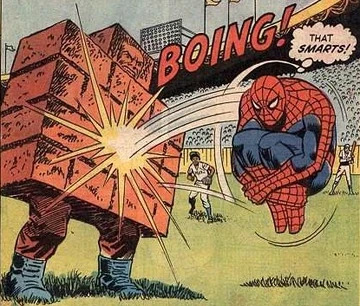
(WARNING! This analysis contains SPOILERS!)
Spidey Super Stories is what you get when you take Spider-Man from The Electric Company and give him a comic run of his own. It’s geared more towards kids, so there’s a lot wackier and out-there concepts on display, and is the originator of not only Spider-Woman (though not Jessica Drew), but also this:
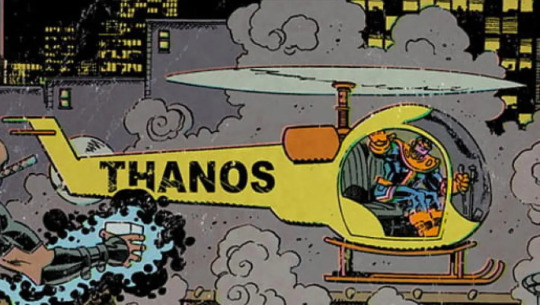
And also this:
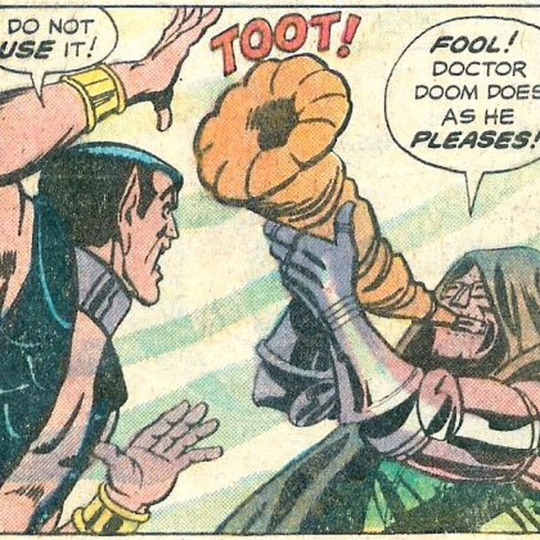
And, of course, the evildoer known as The Wall. Or more specifically, the Wicked Wall.
Now, here’s thing (and I ain’t talking about that other bricked-up superpowered Marvel character): The Wall is a villain in a Spidey series loaded with some of the wackiest and most bonkers one-shot villains ever put to page. Case in point: Thumper, the girl who dresses as Napoleon Bonaparte, wields a boxing glove, and is defeated by being gifted the pony she always wanted since she was a child, a villain who will definitely be getting one of these reviews someday soon. And then there’s the panels like the ones above, where we get the iconic Thanoscopter. How is The Wall supposed to compete with such iconic madness?
Motivation/Goals: My man Joshua here is, quite simply, a hater. He saw Spider-Man was having a day off, and decided, “Oh HELL no, if I gotta be a brick wall I’m making that his problem!”

And he does! In an impressive twist of fate, The Wall manages to get Spidey kicked out of the Mets game the poor hero was trying to enjoy! Sure, he’s kicked out too and he doesn’t seem particularly happy, but a Pyrrhic victory is still a victory. Kind of.
Final Fate: In a fate even the Kingpin would agree is far too cruel, The Wall… is kicked out of the Mets game alongside Spider-Man. They’re last seen moping outside the stadium together.

Best Scene: The guy’s on four fucking pages, let’s just say his entire existence is perfect. But if I’m singling out a tiny sequence, I think this one might be the funniest:

Of course, there's also the sheer comedy of his backstory, where he was a simple boy building a wall when suddenly it fell, somehow turning him into a monster. Maybe the cement was radioactive? It defies all logic in the best way:
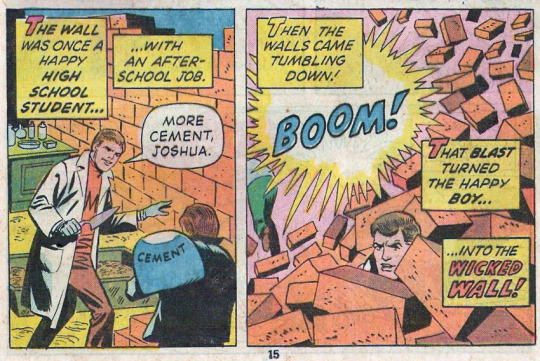
Best Quote:
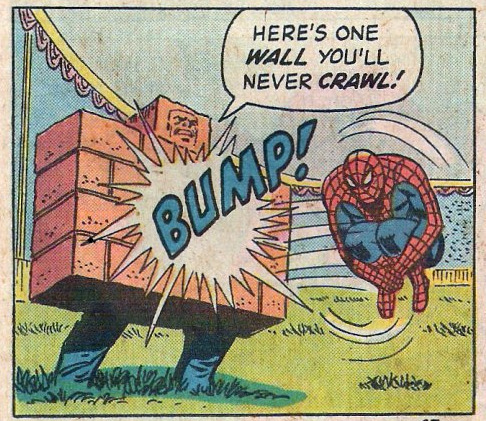
Final Thoughts & Score: The Wall is a great example of the weird, off-the-wall (heh) creativity utilized in comics at the time. He really has it all: A ridiculously punny name that kind of had his fate sealed from birth (Joshua Waldemeyer), no real reason for villainy, an absurd and nonsensical accident that created him that defies any and all logic, a ridiculous yet endearing design, and an endless supply of corny one-liners. This is what goofy one-shot villains should aspire to be.
Of course, that doesn’t leave me with much to talk about in regards to him; there’s no deep complexities or tragic backstories here, just a simple case of a goofy gimmick villain being a lot of fun due to an absurd design and a simple scheme. Unlike the last villain I reviewed, I’d say the relatively simple and straighforward gimmick of being a fucking wall was used to great effect, giving plenty of goofy puns and gags as well as utilizing his bizarre ability to be a nuisance. Like yeah, you could probably swap out The Wall with someone like Rhino or Juggernaut and get the same basic effect, but would it be nearly as funny?
A 7/10 is a fair score for this guy. He’s just a perfectly fun one-shot who, despite only a brief time in the spotlight, isn’t such a terrible idea he couldn’t work if brought back in some regard. Hell, they almost brought him back for Across the Spider-Verse, with his absence being the only thing holding the movie back from true greatness.

I think my only gripes with him are that he's only there for four pages, which while understandable is rather disappointing, but more importantly is that he's in a comic that seems filled to the brim with utter absurdity around every corner. After seeing the Thanoscopter, would you not be comfortably numb to a living mound of masonry? All in all, is he not simply another brick in the wall?
No you fucking goon, he IS The Wall itself. And nothing can take that away from him. If nothing else, I’m definitely going to have to look through more of these Spidey stories to see what other bonkers villains lie waiting for me.
29 notes
·
View notes
Text
Katalepsis Arc 5 - Peek at the Keeper side
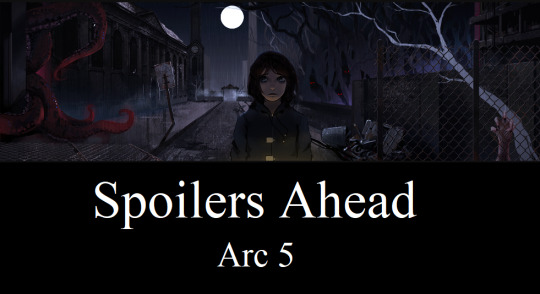
So, I've done some writing (2k words on Divine Blood no less) and read a new arc for Katalepsis. And I think I'll do another level up. Well, not level-up so much as reframing in the perspective of a series. (the author of the game prefers "series" over "campaign").
So, for Monster of the Week there are currently four main types of mysteries based on the central type of threat:
Monsters - The basic sort that the core rulebook covered. A beastie that needs to be defeated and put down. The Monster has a Weakness that must be discovered and used otherwise the monster will just come back, maybe in a later mystery. Dracula is a Monster mystery.
Phenomenon - Introduced in Tome of Mysteries, now included in the core rulebook's optional section. A weird force or situation threatens things. This similarly has a Weakness that must be addressed or it will keep escalating. Groundhog Day is a comedic version of a Phenomenon mystery.
Villain - Introduced in Codex of Worlds. The main threat is a human being with no supernatural powers. Seven (Se7en) is an example of a Villain mystery.
Atonement - Introduced in Codex of Worlds. This is a variation of the above two mysteries but where the best result is one that uses a method other than violence. Instead of a Weakness there is a "Sin" or "Wrongdoing" that must be addressed. There might also be a Weakness allowing the hunters to kill the Monster or end the Phenomena instead of dealing with the root cause, but this usually makes things worse in the long term. Mononoke Hime is an atonement mystery.
There are also Haunts, also introduced in Codex of Worlds, where a cursed location has multiple associated threats and you need to resolve a certain number of those before the Haunt is considered dealt with. Haunts are usually born out of a mix of societal injustice and supernatural forces. In this case, I'd say the societal malignance in question is "the ends justifies the means" or "for the greater good."
Other types of threats that generally don't have a mystery built around them:
Minions - Characters that actively aid the monster. This mostly involves direct minions (Renfield), but I also include side monsters (the ticks in Cloverfield) or characters that making the situation worse even if not directly serving the main threat (the soldiers in Alien: Resurrection). Also note that one of the core book's example mysteries includes Oberon as a "minion" threat despite being the monster's boss, because it does not directly involve himself and you don't need to meet him to solve the issue.
Bystanders - The vast majority of characters in the world. This include basic helpless bystanders to elite spec ops soldiers and even non-hostile supernatural beings. Most of the spirits that Heather sees in the story are probably Bystanders. They sometimes help the hunters and sometimes get in their way. Rule of thumb, if the hunters leave things up to the bystanders, even powerful ones, then the best they can hope for is a Pyrrhic victory. That said, directly working with the bystanders to form a plan for them to do off screen is no longer leaving it entirely in the hands of the bystanders. When Julian Sands' character in Arachnophobia goes off to the barn on his own, that's an example of leaving things in the hand of an expert bystander. Also, bystanders might not be friendly, think of the FBI agent in Frighteners.
Allies - Characters that actively work with the hunters on a regular business. There's going to be less miscommunications between allies and hunters than between friendly bystanders and hunters. But they are their own people and will sometimes have disagreements with the hunters.
Locations - Places. Every place is its own threat. Even ones that are safe places can present dangers in certain circumstances.
Reframing Katalepsis as an MotW series (the author prefers the term "series" over "campaign") Let's look at things so far.
Arc 1 was introduction, basically character creation, establishing how they know each other. So most of this is probably pre-game. Though Apocrypha did introduce a way to do a 30-50 minute mystery that summarizes events.
I feel like arcs 2-4 represent a Haunt: The Sharrowford Cult.
Arc 5 is of an encapsulated single Atonement mystery based around a Phenomenon.
Let's further breakdown the Sharrowford Cult as a haunt. A haunt has a Tenacity score which determines how many of its associated threats need to be resolved before it can be considered finished the creator of this system has suggested that a haunt should have 1-2 more threats than its Tenacity score.
I could set the Tenacity at 3 based on the fact it took 3 arcs to resolve, but I think arc 3 is especially long, and it feels like there were multiple threats resolved in different places. So, I'm going to call it a Tenacity of 4.
Threats associated with the cult:
Alexander Lilburn - Monster: Sorcerer (motivation: To usurp unnatural power)
The Sharrowford Cult - Phenomenon: Conspiracy (motivation: to gather power, keep secrets, and create confusion)
Amy Stack - Minion: Right Hand (motivation: to back up the monster)
Extradimensional Tangles - Phenomenon: Bubble (motivation: to keep inside things inside and keep outside things outside)
Tamed God - Phenomenon: Alien (motivation: to be unfathomable)
Zheng - Monster: Executioner (motivation: to punish the "guilty")
Note that I could have included Lozzie as a threat here as well, but I'm sort of including her as pre-resolved and the Team ally. Also note that the individual cultists and minions might be considered attached to one of the major threats. This would include:
Zombies - Minion: Plague (motivation: to swarm and destroy)
Cultist A - Minion: Cultist (motivation: to save their own skin at any cost)
Cultist B - Minion: Brute (motivation: to intimidate and attack)
Cultist C - Minion: Renfield (motivation: to drive victims to the monster)
Cultist D - Minion: Guardian (motivation: to bar the way or protect something)
Servitor A - Minion: Scout (motivation: to stalk, watch, and report)
Servitor B - Minion: Thief (motivation: to steal and deliver to the monster)
Servitor C - Minion: Assassin (motivation: to kill the hunters)
The types and associated motivations are basically shorthand for the Keeper to know how to RP the character. They don't rule out activities but just point out the first choices. Also motivations can change over time. I considered having Amy Stack as a Villain, but her motivation, especially in this arc, fits the minion types better.
There's a handful of Bystanders:
Heather's Parents: Skeptic (motivation: to deny supernatural explanation)
Spirits/Pneuma-somatic Life: Gossip (motivation: to pass on rumors) / Witness (motivation: to reveal information) / Helper (motivation: to join the hunt)
Christine Hopton: Busybody (motivation: to interfere in other people's plans)
Ben: Official (motivation: to be suspicious)
Lewis Saye(?): Innocent (motivation: to do the right thing) OR Victim (motivation: to put themselves in danger)
Angeline (?): Innocent (motivation: to do the right thing) OR Victim (motivation: to put themselves in danger)
Fox: Helper (motivation: to join the hunt)
And Locations:
Sharrowford: Crossroads (motivation: to bring people, and things, together)
Willow House: Wilds (motivation: to contain hidden things)
Sharrowford University Library: Hub (motivation: to reveal information)
Saye House: Fortress (motivation: to deny entry)
Extradimensional Tangle: Maze (motivation: to confuse and separate)
Dead Jade Castle: Hellgate (motivation: to create evil) OR Den (motivation: to harbour monsters) OR Deathtrap (motivation: to harm intruders)
The Scab: Prison (motivation: to constrain and prevent exit)
Saye Estate: Lab (motivation: to create weirdness)
So back to the arcs.
I feel like in Arc 2 we started with something outside the Cult Haunt and Maisie's Messenger. Maisie's Messenger feels like an Atonement situation with the associated wrongdoing being the separation of Maisie and Heather. When the group chose to banish the Messenger instead, that was basically taking the violent option and it blew up into messing with the Haunt. Otherwise, it would have been a more self-contained story of meeting Twil and getting the message.
Arc two continues into another session where they're dealing with the Cult the first time. They get attacked by the Cult and have to deal with the extradimensional tangle. They solved the mystery by escaping alive, but they didn't use a weakness, so they didn't eliminate the threats.
Through Arc 3, it feels like Evee has been attacking the Conspiracy phenomenon and dwindling it's resources. Also in arc 3, Twil, Praem, Heather, and Raine deal with the kidnapping attempt and take Amy Stack out of the fight, that's 1 on the Tenacity. At the end of this, Heather Big Whammy's Zheng and that's the second Tenacity because now Zheng is a bit out of control.
At the start of Arc 4, an opening into the extradimensional tangle happens and the team attack it, getting through due to Heather's abilities, that 3 on the Tenacity. The cult recovers and takes control of Zheng, so that goes back to 2 on Tenacity. But also here, it appears the cult is finally broken as a main threat due to applied violence (Raine and Twil) and Alexander goes boom. And that's to Tenacity 4 on the whole thing... and now the Cult Haunt is eliminated. No specific weakness is applied in most of these cases, but there's some flex between fiction and gameplay. Weaknesses are mostly meant to insure there is a climax rather than killing the monster early.
Arc 5 is self-contained and deals with the sin of Evee's mother's abuses. There's a little bit of danger but they handle it easily enough and then they deal with the mystery mostly by clearing away alot of the detritus of her mother's experiments. Then they had an encounter with a phenomenon in the form of the Map.
So... I think I'll not level up the characters for Arc 5, though there's some interesting developments here. I think I'll save the level up for Arc 6 (after doing a bit more writing on my own stories)
That said, there's a case to be made that Heather has the Angel Wings move from the Divine. It's a teleportation power. However, her slipping is a bit limited to porting between worlds rather than places in the same world, and it's not nearly as consistent as the move works, so it's probably a "do one thing beyond human ability" magic use.
As to my thoughts.
It feels a bit like Heather is transitioning to the Hex, which is a playbook about tapping into dangerous powers. Mostly because of the bit with the Map at the end drawing her mind in feels very much like a Hex's Temptation. That, however, might be a function of the "Strange Thoughts" I gave her from Changeling or also the influence of the Map itself.
Similarly, I'm wondering if Evee is transitioning a bit towards the Covenant given that she has a lot of focus on summoning things and Praem.
Someone might also make a case about building Twil as The Initiate given her interactions with her church, but no. She has a connection the church, but her inhuman capabilities are far more front and center, and she's very free-thinking meaning that it wouldn't even make sense to give her the Dark Master curse, especially not when she actively flinches around silver and clearly has a Vulnerability.
As for Raine, she's staying firmly in Hard Case territory and while I can't take anymore Hard Case moves, I haven't touched her ability to borrow moves from other playbooks yet. So we'll see about that later.
#roleplaying games#character creation#cosmic horror#katalepsis#monster of the week#ttrpg#rpg#tabletop#family issues#surprisingly wholesome-ish
2 notes
·
View notes
Note
Top 5 angel or angel-adjacent characters?
OKAY so this was delayed by my computer restarting against my will and destroying the draft. It's okay :') I feel like my list is probably going to be lamer than expected anyway, haha. I suspect this will be a very lame list as well... the shameful fact is for all the time I spend looking at illustrations with angelic motifs, I don't spend much time with angelic characters in stories.
Tristian (Pathfinder: Kingmaker)
This game has some kind of malign influence on my life.
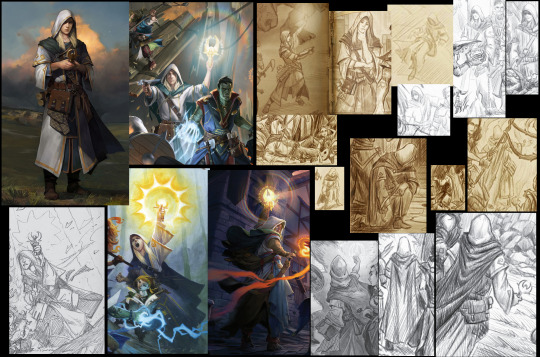
2. Gabriel (Constantine)
I don't think Constantine is a good movie and I did not enjoy rewatching it as an adult. It turns out the reason I remembered it as being a bit befuddling when watched as a child (I think I caught the back half on tv once?) is because it's just not very good. But do you know what was even better than the pristine memory burned into my mind? Gabriel. Gabriel. Gabriel is so unspeakably perfect on screen. So soft and imposing. So lethal and forceful. Beautiful when in that prim and proper suit, and a vision as a white clad warrior! That twisted philosophy of making humanity "worthy" of love... this had some kind of profound impact on my developing brain, I fear. As a side note, I think there aren't a whole lot of feathery wings that look good in live action stuff, but Gabriel's are actually pretty solid! It probably helps that they're not onscreen much, and not generally static when they are.
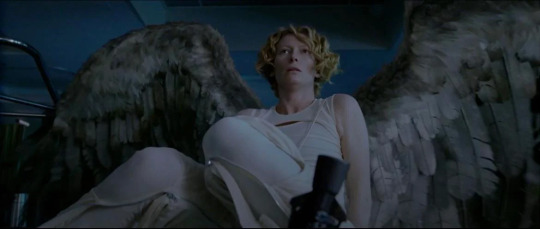
3. Angel of Death (Hellboy II: The Golden Army)
I'll be real with you, I remember borderline nothing about Hellboy II, which I last watched when I was 9. But do you know what I remember? The Angel of Death. I remember the Angel of Death so vividly that when my ex had proposed we watch Hellboy I got Really Excited about seeing the Angel of Death and finally getting some context on that vague memory. And do you know what happened? The Angel of Death isn't in the first movie! Betrayed! Bamboozled! And for the rest of the night my ex kept calling me an angelfucker because I was so vocally disappointed.
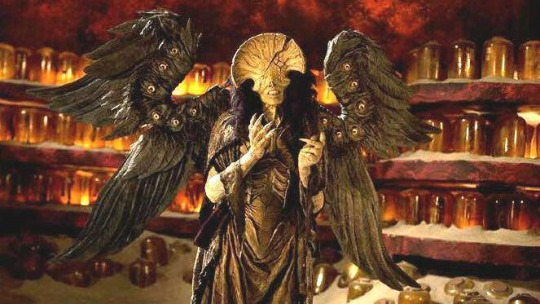
4. Satan (Devilman)
I'll be real with you, I absolutely saw Crybaby before any other Devilman related thing and this is ummm. Not insignificantly influenced by my feelings about long haired Satan. Anyway. I love a good Satan. Everyone loves a good Satan. I love the deep commitment Satan has to his/their chosen people (the demons) and how desperately he/they works to preserve them. I'm also a huge sucker for a good pyrrhic victory, so what I'm really hooked on is the sincere, pure affection that Satan then develops for one special human who refuses to be taken in and sheltered and protected and saved from the annihilation of humanity. The ultimate symbol of Satan's victory is the destruction of that precious connection, and that's all it takes to make it all feel like it was for nothing. What a pure heart! And then there's all the time loop stuff as well, which is Spicy
Anyway, all Satans are valid but I'm only including one pic, so enjoy long haired Satan.
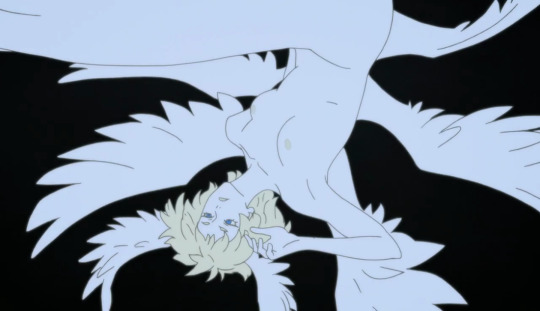
5. The Wood Sprite (Guillermo del Toro's Pinocchio)
This is mostly an aesthetic pick... the truth is that as a character I liked Death better. But like. What an aesthetic. Is it cheating to pick two del Toro designs? I resisted the temptation to add Death as well!

Still, it feels a more substantial choice is needed. Thus, I cheat:
5. 82 White Chain Born in Emptiness Returns to Subdue Evil (Kill Six Billion Demons)
White Chain is a fantastic character with a substantial character arc dripping with ye olde trans allegory (we love a good trans angel in this house). She struggles throughout the series with the conflict between what she understands to be her duty as an angel upholding cosmic law and her compassion for mortals and desire to protect them. Already an outcast among her peers, she fears further alienation. Her form has also been becoming steadily more human-like: messy, complicated proof of connection she's desperate to deny and her superiors wish to stamp out. Her struggle to grow into her own identity is one of my favorite side character arcs in the comic.
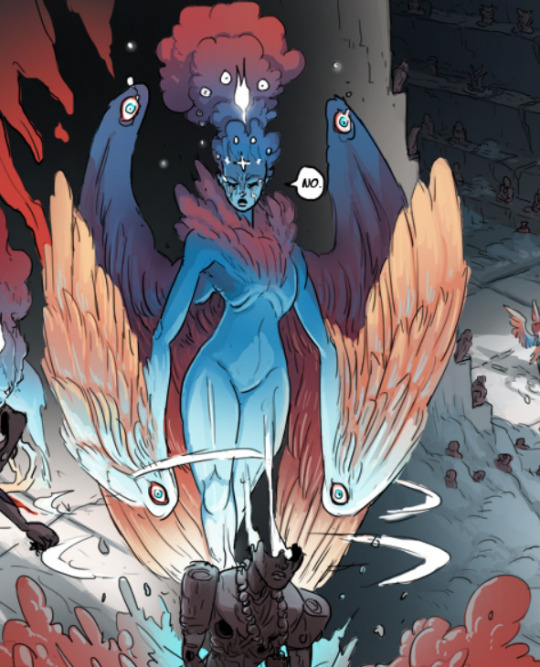
4. Satan (Devilman)
I'll be real with you, I absolutely saw Crybaby before any other Devilman related thing and this is ummm. Not insignificantly influenced by my feelings about long haired Satan. Anyway. I love a good Satan. Everyone loves a good Satan. I love the deep commitment Satan has to his/their chosen people (the demons) and how desperately he/they works to preserve them. I'm also a huge sucker for a good pyrrhic victory, so what I'm really hooked on is the sincere, pure affection that Satan then develops for one special human who refuses to be taken in and sheltered and protected and saved from the annihilation of humanity. The ultimate symbol of Satan's victory is the destruction of that precious connection, and that's all it takes to make it all feel like it was for nothing. What a pure heart! And then there's all the time loop stuff as well. Who doesn't love being eternally trapped in a purgatory of realizing one's mistakes just a little too late to avert them.
Anyway, all Satans are valid but I'm only including one pic, so enjoy long haired Satan.
Honorary mention purely so I can add pictures of her: Eniale
Comedy isn't really my favorite genre, so I didn't expect much of Eniale & Dewiela. But the characters certainly have a lot of charm, and Kamome Shirahama's breathtaking art does a lot to make every moment feel special in a very light hearted series. I have a very strong fondness for Eniale. She's just a little goofball. She's a terrible angel and doesn't work even half as hard as her demonic counterpart (and self-consciously notes that she's far less powerful). She means so well, but she's shallow, airheaded, and selfish, and just tends to cause as many problems as she solves. Despite that, she's incredibly sincere and passionate when it counts. I really love that. She's just a goofy lil scamp! She's a goofy lil scamp and she makes me smile. Also here are some pictures of her.
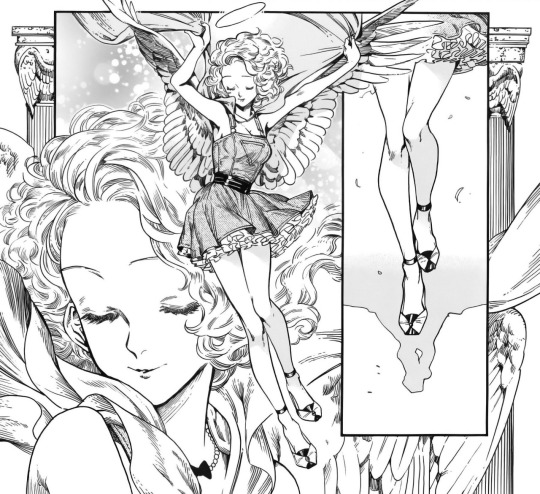

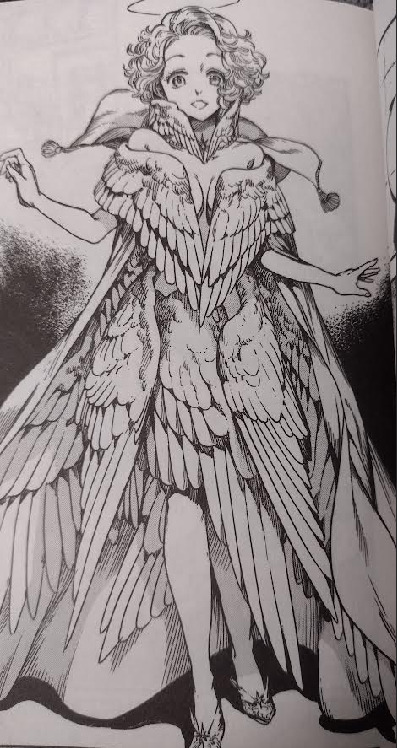

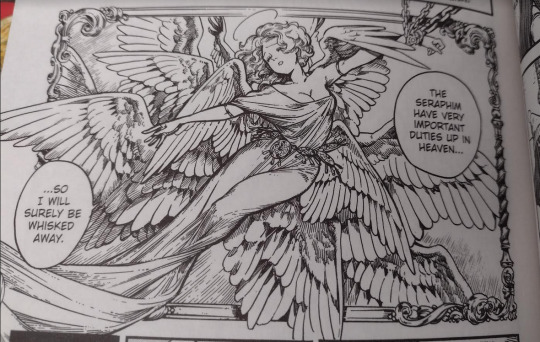


#eniale & dewiela also has a very lovely gabriel! the other gabriel who didn't make the cut was ultrakill's#I really love how expressive eniale's wings are! ahh... when I look at them I want to work a little harder#anyway sorry this took so long and then isn't a super interesting list haha#there's someone on twitter with a really lovely feathery abomination angel but I don't know the character's name...#ask me emithing#ask game#turbulentpumpkin43
12 notes
·
View notes
Text
The themes from Silent Hill 2 aren't complex. It encompasses the human condition through rigorous stress, paranoia, anxiety, and anger. People who want to be good but via means of just being human make grave mistakes that morally condemn themselves. What IS complex is when you take two of those creatures and put them in a room together and tell them to play nice with each other's vices. This is usually done with James as one of those characters.
So recently I've been seeing people complain about an interaction between James and Angela where James gets stern and raises his voice with her and she responds by calling out for her mommy. The lack of compassion from not understanding the trauma Angela has and the reason why James did what he did has been hard to watch. Piggybacking on the awful comments about Angela not being sexy enough is just like.... Really painful. I don't know why some people play the SH games maybe they just like the settings and the monsters. But the irony being lost on some of the playerbase behaving like the monsters in the game is more shocking than I realized.
I personally love the SH series of games because of the psychological horror and in depth character analysis of humanity being put to the most rigorous of tests and just coming out the other side. No triumphant victory or gilded reward. Just... Figuring out how to fight your own inner demons and not reduce yourself to a completely paralyzed ball off emotion. To me that feels real because life rarely has sweeping victories more like a pyrrhic victory.
0 notes
Text
The Price of Ambition
read it on the AO3 at https://ift.tt/8i9aMNL
by TheEigthPillarGeneral
After a long battle and a pyrrhic victory, Akira Nishikiyama, the fallen prince of the Noldor, sets out to take responsibility for his actions.
Words: 1265, Chapters: 1/1, Language: English
Series: Part 1 of Yakuza in Middle Earth
Fandoms: 龍が如く | Ryuu ga Gotoku | Yakuza (Video Games), The Silmarillion and other histories of Middle-Earth - J. R. R. Tolkien
Rating: Teen And Up Audiences
Warnings: Creator Chose Not To Use Archive Warnings
Categories: Gen
Characters: Nishikiyama Akira, Shindo Koji, Seong-Hui (Yakuza), Han Joon-gi | Kim Yeonsu (Yakuza 7)
Additional Tags: Alternate Universe - Fantasy, The Silmarillion References, Inspired by The Lord of the Rings, Angst, Nishiki as a Feanorian Prince, Except he's got a chance at redemption, Elves, Seong-hui as Galadriel, Joon-gi Han as Haldir
read it on the AO3 at https://ift.tt/8i9aMNL
0 notes
Text
YES, SO MUCH THIS. Having so many different readings/interpretations and being able to move between them is such a wonderful form of play!
I think there's also a big difference between being aware that multiple readings exist and selecting which ones you want to focus on vs. refusing to acknowledge that other interpretations exist. Some of the best fanfics I've ever read have come from writers with an impressive knowledge of canon gleefully tossing out all the elements they don't like and substituting their own, or taking canon elements to their logical conclusions in unexpected ways or switching genres/settings--and it works precisely because they understand what rules they are breaking and why.
My original post was inspired by me witnessing one too many PMMM power scaling debates - "Who is the strongest magical girl?", "Who would beat whom in a fight?", etc, etc. - from people determined to prove that their fave (in this case, Homura) is the best. This is so funny because one of the things that I love about Homura is how much she straight-up fails in spite and because of her abilities (e.g, she gets tied up and rendered helpless by Mami THREE SEPARATE TIMES). Having her curb-stomp everyone 100% of the time would be so much less interesting--I hear One Punch Man gets good mileage out of that particular premise, but I suspect that's an exception rather than the rule.
(I've also seen people argue, "Homura can beat Walpurgisnacht solo, just look at the PSP game!" and while this is technically true, she dies immediately afterward in a Pyrrhic victory, which, in my opinion, only doubles down on the symbolism/metaphor even harder. Also, by definition, this is something that couldn't have happened in the main series because Homura is still alive and fighting Walpurgisnacht right up until the end.)
As a writer, I find power scaling arguments especially tedious, because I determine who wins and who loses any given fight by what best suits the story I'm trying to tell -- and thus it's not an absolute measure of talent or power by any means. Given any two characters, I can come up with scenarios where Character A wins, and scenarios where Character B wins; which one I pick depends on the narrative and circumstances, not because I think Character A is inherently superior to Character B in all respects and vice versa.
In general, I stage my fight scenes like Pokemon battles--some characters are strong against certain opponents and weak against others, and there is rarely an absolute "best" who could take 100% of their opponents 100% of the time. And I try to pit characters against what they need/fear the most, where their success or failure depends as much on their emotional/mental state as their physical one.
Power scaling can be fun and a form of play in and of itself, and I'm not here to tell people that it's wrong or they should stop doing it. However, from my perspective, it tends oversimplify things in a way I find uninteresting precisely because it ignores the metaphorical/symbolical readings in favor of the purely literal and generalizing from there.
There is a tendency I see in PMMM analyses and discussions to treat the witches simply as monsters that can be overcome with sufficient force regardless of other circumstances--and thus Homura's failure to ever win against Walpurgisnacht on her own terms is something that could be easily fixed with more firepower and different tactics. And while there's nothing wrong with this interpretation, it's not one that particularly interests me, either.
What I like about PMMM and what makes it so engaging for me, is that it can be read on multiple levels--both as a literal journey and as a symbolic one. In-universe, witches are the shadow selves of magical girls; is it really so surprising that they also serve as narrative foils to those who face them, thus making victory or defeat as much of a character issue as a tactical one?
It is not a coincidence that Mami Tomoe, a girl who was forced to grow up too fast and who could have wished to save her dying parents but didn't, meets her end at the hand of a particularly childish and immature witch, a lumpen, misshapen doll that transforms into a clown--a girl who never grew up, who could have wished to save her dying parent but didn't. Mami, an experienced veteran who wiped the floor with the Rose Witch and her familiars earlier, is completely caught off-guard and is eaten alive by a witch who embodies all of the issues she herself struggles with and has yet to overcome within herself.
Yes, Mami was careless and overconfident, which led to her doom--but she had also fulfilled her role of introducing Madoka to the world of magical girls. On a narrative level, her death was necessary--not only to free Madoka from her impulsive promise to become a magical girl too early in the story, before she'd learned all the facts and could make a fully informed decision, but also to teach Madoka one final, horrific lesson about what life as a magical girl is really like.
This is not to say that AUs where Mami survives are wrong or missing the point--I've written them myself and I love them! (It helps that Mami's survival is usually the result of someone else's interference, not something she accomplishes on her own.) Nor do I mean to suggest that Mami's death is a moral failing on her part--merely that I think that Charlotte represents Mami's own particular brand of kryptonite at that particular point in her life, one she might have been able to survive if she had been able to move beyond the psychological issues hobbling her.
Meanwhile, Homura is able to easily defeat Charlotte, because metaphorically she's moved beyond the childish worldview that Mami is still stuck in. From that same symbolic perspective, it's this relative level of maturity, as much as her time stop and pipe bombs, that allows her to win.
Likewise, it is not an accident that the next witch Madoka encounters is one that specializes in extracting the memories of its victims, trapping Madoka in a spinning carousel as she is tormented by her own grief and guilty conscience over Mami's death. She is freed by Sayaka, who has moved beyond such angst by her decision to take on Mami's role as an idealized magical girl protector. Later on, Sayaka's descent into dualistic thinking is symbolized by her fight against a witch whose world is literally black and white--whom Sayaka defeats, but only at the cost of pushing herself dangerously to her limits.
As with Mami, Sayaka's death is directly tied to her own psychological issues--in this case, by her incredibly strict rules about how magical girls should behave and her refusal to cut herself any slack whatsoever. Her metaphorical self-denial results in literal self-denial, and her death as a magical girl and rebirth as a witch.
Then we come to Walpurgisnacht, a witch made of cogs and gears--the one witch Homura cannot beat, no matter what she does. Homura is stuck in her loops, unable to imagine a future beyond them, increasingly isolated from any meaningful connections or relationships--Walpurgisnacht may be the "fool that spins in a circle", but so is Homura. The inside mirrors the outside; when we watch Homura fight against Walpurgisnacht, we are also watching Homura's struggle with herself. Unlike Mami and Sayaka, Homura's magic allows her to fight this battle over and over again--again and again she is forced to retreat and start over, unsatisfied with the results and determined to do better next time. She doesn't die, but she doesn't win, either--instead, she's locked into perpetual stalemate with no end.
Madoka, however, is able to see beyond the vicious cycle represented by Walpurgisnacht and thus easily and repeatedly defeats an enemy that Homura cannot, regardless of her relative power levels in any given timeline. It's probably too simplistic to say that hope triumphs over despair--and yet, that's exactly what happens, every single time. Homura has numbed herself through repeated exposure to where she no longer feels hope or despair, thus existing in perpetual stasis with her purpose the only thing driving her. Paradoxically, the one thing she needs to do to win is the one thing she cannot do--and the thing that Madoka can do all too easily.
(This is not to say that Madoka doesn't have her own issues--she does!--just that her issues are different from Homura's, meaning she's not tripped up by this particular obstacle in the same way that Homura is. And it's not that Homura's struggles were pointless--they were what allowed Madoka to get to point where she had both the power and the knowledge that she could save everyone, including Homura.)
Homura's final battle with Walpurgisnacht shows Homura going to insane lengths, including a wall of C-4 explosives inside a refinery, a flaming oil tanker, and a submarine with Type 88 Surface-to-Ship missiles--none of which has any lasting effect on Walpurgisnacht whatsoever. That episode goes to great lengths to show that Homura's approach to fighting Walpurgisnacht fundamentally isn't working; I don't think adding more nukes would help.
The one time Homura gets the closest to her happy ending is the one timeline where she and Madoka fight and fall together--the one timeline where they are shown as equals, and the one where they debate becoming witches together and destroying the whole world before Madoka thinks better of it. This is also not a coincidence. If there is ever to be a truly happy end to this franchise--or an end at all--Homura and Madoka must be equal and willing partners, not one protecting/sacrificing themself for the other again and again. It is also likely that they will remake the universe in the process, through the combined power of their mutual wish.
[It also wouldn't surprise me if that line foreshadowed future plot elements--after all, Madoka technically became a witch in the final episode of the TV series (she got better, thanks to the nature of her wish), and so did Homura in Rebellion--but we shall see if the series ever follows up on this.]
This is why I'm so excited that Walpurgis no Kaiten seems to be laying the groundwork for Homura creating her own enemies and her greatest enemy being herself--once again, making the metaphorical literal. I'm excited about the prospect of Homura getting a do-over with Walpurgisnacht, which would represent a chance for her to confront her narrative foil one more time, and show us how her character has changed. Though it may play out on a larger stage, the real battle will be inside Homura's mind and heart--and, I would argue, always has been. The only way the outcome will change--the only way we can move beyond what's been and into something new--is if/when she changes.
I want to be clear that there's absolutely nothing wrong with the strictly literal interpretation of witches, and I think people should write what they want to write; if that's the story you want to tell, then go for it! For me, however, I find it far more compelling--not to mention richer and truer--if the actions and words on-screen correspond to the characters' emotional and psychological journeys, and there's no question that this preference how I interpret media in general, and PMMM in particular. And it's not that I think Homura couldn't defeat Walpurgisnacht in an AU scenario--merely that any story where she achieves this victory without changing in any way or addressing her own psychological issues in some fashion removes exactly the elements that drew me to this series in the first place.
1K notes
·
View notes
Note
i just want to say i'm rereasing the series and i LOVE how there are basically zero authority figures the kids can trust. Like the Andalites have their whole Blue Man's Burden, the Chee are pacifists but manipulative and disinterested in humanity, GOD HIMSELF descends upon them and offers help and they're like "whats your angle asshole?"
I agree that that's a huge part of what makes the series so good (and so original): the complete lack of mentors.
Like, I know of very few other children's series that have no one a group of middle schoolers can ask for guidance. Even series that kill the mentors early on (Pendragon, Eragon) don't kill them after a single freaking conversation the way we get with Elfangor. Even series that have the kids obtain mentors late in the game (A Wrinkle in Time, Homecoming) still present said mentors as basically effective, not paralyzed and worse-than-useless like Michelle and Naomi. Even series where none of the adults are trustworthy (Percy Jackson, Maze Runner) will have child mentors with at least some more knowledge of the magic system than the protagonists, not a comparable level of near-total ignorance like Cassie has about morphing or a desperation to be mentored themselves like Ax shows.
Anyway, I love how much Animorphs throws the poor protaognists in on the deep end. And I love how much time they spend losing battle after battle as a result. It's not until about #6 that they're even minimally competent, not until #7 that they actually win a battle, and arguably not until #52 that they do more than harass and inconvenience the yeerks. Because it takes them that freaking long to become their own experts. And by the end of the series they're the ones parenting their parents, the ones acting as authorities over the government, the ones who have the hard hard won knowledge of how this war works that allows them to earn a satisfying if pyrrhic victory.
And even after having read the series (several times), I still can't tell how Applegate pulled it off. Because having to have the characters learn everything all on their own is dang hard to write, and dang cool to read.
#animorphs#animorphs meta#animorphs spoilers#general children's lit spoilers#don't get me wrong i love a good *flawed* mentor#e.g. luke castellan or haymitch abernathy#but animorphs is just super cool and i have no chill
289 notes
·
View notes
Text
so I’ve finally gotten around to watching dhmis, the television series, which i was wary of because honestly i think this kind of story does better in a shorter format. but all that aside, i think i finally understand the “lore” behind the series. here’s my theory:
1. yellow guy was once a child prodigy of some kind. he invented a “third symbolic subset” outside of both numbers and letters, and worked with these seemingly magical symbols to study spatial distribution. spatial distribution of what? unimportant.
2. what is important is what yellow guy invented: a way to store space inside of space. a pocket dimension, essentially, and a way to control that pocket dimension with his symbols
3. yellow guy then dies in a tragic accident, leaving his parents, Lesley and Roy, in relative agony. Lesley uses yellow guy’s journal, and the magic symbols therein, to recreate a pocket-dimension of their old home. nothing inside of it feels quite real—thus its puppet-y nature. but here she can create replicas of everything she’s lost… her son, and his two friends (who may have been his friends since before the accident or may have just been two random people Lesley found)
3. Lesley, now insanely messed up after maintaining this pocket dimension for centuries (long past since the apocalypse occurred in the outside world) enjoys torturing the Three Of Them endlessly via the Teachers. Roy dies at some point along the way, but she simply replaces him too. Roy isn’t important. he’s just a messed-up maintenance guy for this universe
4. there’s just one problem. yellow guy is too intelligent. he figures out he’s in a pocket dimension every time. so Lesley intentionally handicaps him by providing him with “weak batteries.” when he miraculously gets his batteries replaced anyway, Lesley decides to play one last endless game, and gives him back his old journal so he can finally figure out how this world of his works
5. Lesley does this knowing full well that the instant red guy and duck see yellow guy again, they will tear out his batteries and replace them with his old ones. after centuries or perhaps millennia of torturing them, that’s how well she knows every possible choice they could make. and she knows that low-battery yellow guy, with the journal containing the only true key to his freedom in his hands, and with a shredder nearby, will choose to shred.
of course, there’s a second layer to all this, which is that the series as a whole has grown more complicated as time goes by. just as there is more attention to detail, and more puppetry, better sets, more voice actors, etc, with each new generation of the show the lore grows deeper, and escape becomes more and more impossible. even if the Three Of Them manage to escape their hellscape in one series, the next reboot will just put them right back where they belong. that’s the true, cosmic-level horror at the heart of the series… not Roy or Lesley, but The Show itself
if you’re wondering how all this relates to the original series, where red guy seems to escape temporarily to the real world and Roy seems to be controlling everything via the Control Panel… there’s a simple explanation:
1. Red Guy either did escape to the real world, in which case the presence of many other “red guys” there implies that he has escaped many times and simply been replaced, or he never escaped at all and merely believed himself to be in the real world
2. If we accept that red guy did escape into the real world in the original series, then that places the original series before the apocalypse, possibly hundreds of years before the tv series. this in turn explains the control panel being replaced by Lesley’s dollhouse and piano… it simply evolved over time. any sufficiently advanced technology is indistinguishable from magic, after all
3. when red guy unplugged the control panel, he only achieved a pyrrhic victory—he destroyed his entire universe, and Lesley had to reset everything. why she chose to replace everyone’s original colors, i don’t know
lastly, if you’re wondering how Lesley managed to keep herself alive so long if this series has continued across hundreds of years… look at those stitches on her face. notice how we only ever see her gloved hands. Lesley taxidermied herself somewhere along the way. she’s a puppet, too
#dhmis#don’t hug me i’m scared#don’t hug me im scared#long post#sorry everyone who doesn’t care about this i don’t really care either but my brain is incapable of seeing Lore without#trying to scrape some sort of framework together#the stairs at the end… Lesley IS at the top of the ladder. she IS the person who created this pocket dimension… FOR NOW#next time the story is rebooted (if ever) we will see who or what is controlling Lesley. with each reiteration the story gets wider#with each reiteration the hole gets deeper
57 notes
·
View notes
Text
A Year Of Metal Gear – Part 1
12 Days of Aniblogging 2021, Day 4
Yes, the Metal Gear franchise is anime. That should be obvious.
All the way back in January I persuaded my girlfriend to play through the first Metal Gear Solid game with me, agreeing that we'd would continue through the series if she liked it. This went spectacularly well, and by September, we had completed MGSV and everything that had come before it. Playing through all the Metal Gear Solids has somehow been a great bonding activity, and with their batshit narratives and surprisingly complex themes, it’s given us endless things to talk about even after the fact.
Since all of the games are relatively fresh in my head, I’d like to carve out some blog posts this year to just ramble about what each Metal Gear game intends to say, and what messages actually come through. There are plenty of thematic threads to follow across the series, but, being me, I will focus in on the gay shit. I will likely be spoiling every game I talk about. It’s showtime.
Metal Gear Solid (1998)
There’s a reason this is regarded as one of the most influential games of all time. The first Metal Gear Solid not only popularized a genre, it brought in-engine cutscenes to prevalence, established the standard of actually having cinematic direction in your games, and most importantly, set the standard for what a “Metal Gear Solid” game is.

Despite me routinely edifying Kojima’s writing, the specifics of Metal Gear Solid (1998)’s plot are not the most relevant part of it. The premise and execution of its story are overshadowed by the games that elaborately respond to it, 2 and 3. There are specific story beats that fall flat, such as Meryl’s arc as a means to discuss women’s capabilities on the battlefield and pastiche the damsels-in-distress of the 80’s action movies Kojima loves so much. The MGS franchise as a whole has a lot to say about gender, as you’ll see throughout these posts, but interfacing with these questions too directly can bring out Kojima’s more misogynistic and uninteresting writing tendences. His heart clearly lies with men, combat, and sexual deviance through men and combat, not a tomboy who wants to experience the battlefield but is secretly too inexperienced/pure of heart/feminine to get anywhere.

Pretty much everything else in the story is perfect though, and what you’re getting is an 8-hour romp through an extended spy movie full of twists and theatrics too stupid for Hollywood. Our Snake-hero is sent into a secret facility to defeat the terrorists and stop a nuclear launch, only to arrive and gradually realize that everyone, including his benefactors, are lying through their teeth about what’s going on. The game weaves its way deftly through sob stories and hilarity, remaining a deeply entertaining romp until about the three-quarters marker, where it switches gears and becomes dead serious in comparison in order to soapbox about its main themes, which here are Genetic Destiny with a side helping of Love On The Battlefield. The titular Metal Gear is destroyed, any victory for the Snake-hero is largely pyrrhic, and the player is left to interpret the hodgepodge of themes as they will. This is the format the rest of the games run with, and the first Metal Gear Solid is a near-perfectly-executed template for all future games to look to.
Don’t think “template” means “normal” though. Even in its most base form, Metal Gear is still fucking weird. Right off the bat, we must face a central paradox of its world: the setting is high-tech but largely grounded in realism, except there’s also just some guys running around with actual magic powers, and this is contradiction is never addressed in-universe. Every MGS game worth its salt has a Villainous Team whose powers range from “good with a weapon” to “can control animals” to “straight-up psychic powers”.

The occasional supernatural characters aren’t even responsible for a most of the franchises’ textbook strangeness. Most of it comes from the tone of the games themselves. A Metal Gear game always takes itself seriously, even as a man gets his arm cut off by a cyborg ninja or a psychic reads the player’s Playstation memory card and asks them if they like Castlevania games. This humor comes from the endlessly hammy voice acting and the overlong cutscenes containing full emotional rollercoasters in of themselves.
Otacon is first introduced hiding from the previously mentioned cyborg ninja, pissing his pants while cowering in a locker. Once rescued by Solid Snake, he goes right into his tragic backstory, delivering a long-winded speech about how scientists like him are routinely lied to and exploited by the government and used as tools of war. He then clarifies that his name stands for “Otaku Convention” and starts talking about how anime influenced his career. The greatest thing MGS does with its humor is that it refuses to create joke characters with it. You will be forced to seriously care about Otacon, because no matter how stupid his introduction is, he ends up a deeply compelling character.

A lot of hypermasculine media is branded as “secretly gay” but I think Metal Gear Solid is the one series that truly deserves that, no matter how many times its practically-textual sexuality sails over straight player’s heads. The very first Metal Gear game is already a tour de force when it comes to this. In plot order:
Solid Snake, our protagonist with a tactical harness and a nice ass, meets Meryl, the Girl of the game. He snidely dismisses her for her femininity and her combat virginity.
Snake encounters Revolver Ocelot, a man with countless secret schemes and an unquenchable thirst for any man bearing the “Snake” codename. During their fight, Ocelot delivers the line "I love to reload during a battle! There's nothing like the feeling of slamming a long silver bullet into a well greased chamber." This man is down bad.
Snake faces off against the Cyborg Ninja, a man plucked from the battlefield by the U.S. government and experimented on until he becomes a half-dead machine in a constant state of anguish and insanity. He begs for release, but not before meeting a real match in combat, forcing Snake to use his fists instead of his firearms. Towards the end of the fight he stands still and shouts “Hurt me more” repeatedly, practically begging for it. It’s very apparent how much he’s getting off on his pain.
Snake, having rescued the Girl, is ambushed by Psycho Mantis, a weirdo even by Metal Gear standards. He is very obviously clad in fetishwear, from the O-ring chest harness to the leather to the gas mask. At one point while mind controlling Meryl, he taunts Snake about “not liking girls”.
Snake gets captured by the enemy and wakes up shirtless, strapped to an electroshock machine. Revolver Ocelot looms over him and reveals that he is also a torture expert/fetishist. Ocelot repeatedly electrocutes Snake to try and force a confession out of him, using very specifically coded words such as “submit” when talking about giving up.

Having normal ones
If Solid Snake submits to Ocelot, Meryl dies and he has to escape the facility with Otacon. The two share a surprisingly vulnerable conversation about their true names and leaving behind their past lives, using a 2001: A Space Odyssey joke about going to Jupiter to propose forging a new path together. This is not the ‘canonical’ ending but it feels more sincere than the ‘true’ one, which aims for a more standard action movie resolution about getting the girl. By the events of Metal Gear Solid 4, Solid Snake and Otacon are living together and raising a child, so I believe that this ending is fully vindicated in tone.

So there you have it. Underneath the façade of tactical espionage action is a tale of men expressing strange but sincere intimacy with other men through the guise of a war zone. When Otacon asks if love can bloom on a battlefield, it’s hard to ignore this lens, especially since the scene is set up in such a way that it totally looks like he’s about to confess to Snake.
BONUS: Metal Gear Solid: The Twin Snakes
The Twin Snakes is a Gamecube remake of MGS1 using the same engine as Metal Gear Solid 2 and 3. As such, its visuals are more in line with those games. The voice acting is redone to mixed results, and the backported first-person aiming is fun but does break a boss fight or two. However, the most drastic changes are in the cutscenes. Kojima, otherwise uninvolved in the project, requested that The Twin Snakes differentiate itself from the original. The new director, having presumably just watched all the Matrix movies, went to town. What we get is a Metal Gear Solid that throws subtlety through the roof, exchanging restrained fight animations for bullet time, backflips, and all sorts of then-trendy choreography. It’s a matter of taste at the end of the day, but I’m of the mind that it rules. Some of the quieter, more emotional scenes suffer a bit, but I’m willing to go to bat for The Twin Snakes as a perfectly reasonable way to experience the first Metal Gear Solid, especially if you enjoy the more overblown parts of the series.
Metal Gear Solid 2: Sons of Liberty
This is where things start to get really interesting. Metal Gear Solid 2 aims to be not just a sequel but also a deconstruction of Metal Gear Solid 1. This was groundbreaking stuff in 2001 and it’s still a cut above when any other big-budget game tries to be “deep”. This metanarrative is compelling, and the main themes are perhaps the best in the series, tackling information warfare, censorship, memes, and post-truth society effortlessly, years before the real world was plunged into these same dilemmas. There’s a million angles to poke at it, but I primarily want to analyze MGS2 through its main character, Raiden.
In the first Metal Gear Solid we are Snake, the gruff everyman retired soldier who happens to be a stealth expert. MGS2’s most famous trick is making us think we’re getting another Solid Snake game, then killing him off an hour in. This leaves the player with a poor imitation of Snake, the blonde bishie himself, Raiden.

Raiden is about as far from Snake as you could get, despite wanting to be him so bad. He’s a rookie with feminine grace and fragility as opposed to toughness. He bickers and whines, and his ass is terrible. MGS2 is obsessed with emasculating Raiden, in the same way that MGS1 is obsessed with sexually tormented men. Raiden fails time and time again at his mission objectives. He argues with his girlfriend over the codec, who is both worried and fed up with him, as their relationship breaks down in real time.
In fact, the moment Raiden steps onto Big Shell, the Colonel starts explains that his sneaking suit is cutting-edge. Raiden complains that there’s a lot of pressure around his crotch, and the Colonel responds that it’s meant to be skintight to maximize performance. That’s right, Raiden’s objectified into the “sexy catsuit girl” role yet still forced to run around and pretend like he’s doing something to save the day. He is mocked relentlessly by everyone involved, and he kind of deserves it.
I can’t talk about sexuality in MGS2 without bringing up Vamp, the infamous miniboss who sucks blood and has superhuman speed and can shrug off all wounds, who is not named ‘Vamp’ for any of this, but rather because he’s bisexual.

It may seem like a non-sequitur, but Vamp’s sexuality really is a threat a Raiden! Vamp is openly and flamboyantly queer during a time when Raiden wants so desperately to be what he thinks Snake is, a tough straight-laced hero. In this sense, Vamp is as much an ideological foe as he is a physical one. Though the relationship between Vamp and Raiden is not overtly sexual (you’ll have to wait until MGS4 for that), it does place Raiden as the submissive one between them due to his lack of experience and personal values he's willing to fight for. Yet again, Raiden is emasculated.
This is all vaguely subtextual until the President of the United States grabs Raiden’s dick.

Once Raiden finally accomplishes something and rescues the president from the clutches of terrorists, he learns that the villainous Patriots have already extracted all the information they needed from him. The president, expecting the Patriots to send a female assassin to finish him off, gropes Raiden’s crotch area and is genuinely surprised that he’s a man. This is perhaps the most emasculated you can get! The person in the highest symbolic position of power in the world not even parsing you as a guy. I’d willing to chalk this scene up as a jab at the then-recent sexual sleaziness of Bill Clinton, but it slots in perfectly with the rest of Raiden’s degradation. Future Metal Gear games go on to establish the dick grab as a marker of dominance and exposure of fraud, effectively canonizing this moment as more than just a random joke.
When Solid Snake finally shows up again, having cheated death, the game makes it clear that this man really is just better than Raiden. The climax of MGS2 has Raiden being tortured by…you guessed it, Revolver Ocelot, in an elaborate recreation of Snake’s torture scene from the last game. When Raiden escapes, it is not heroic but rather his lowest point. He is bare naked, forced to cover his crotch from the player’s eyes, sniffling from a cold, and bombarded by taunting messages from a rogue AI pretending to be his girlfriend and his boss.
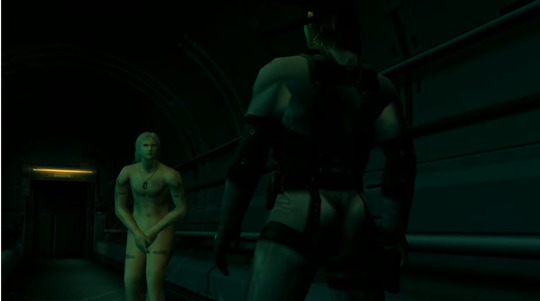
Raiden was selected for his mission specifically because of his weak-willed nature. The malevolent Patriots wanted to see if they could bend even the prissiest brat of a soldier into a Snake-like figure in order to test their own image training and information control programs. This makes Raiden a vessel for ideology, with every character he runs into imprinting a bit of themselves into him, whether he likes it or not. This will be important in understanding his role in MGS4 and particularly Rising. At the end of Metal Gear Solid 2, Snake tells Raiden to think for himself and pass down the cultural memes that he thinks are the most valuable to the world. Of course Raiden laps this suggestion up, but it’s hard to say whether he really gets to put it into action, because by his next franchise appearance, he has thrown away that ideology for something different yet again.
Of course, most straight Metal Gear fans failed to understand any of this and concluded that they didn’t like Raiden because he was a pussy, or whatever.
_
Tumblr only lets you add so many images to a single post, so I'm going to cut this one here. Tomorrow, we'll look at the third and fourth Metal Gear Solid games with the same critical eye.
98 notes
·
View notes
Text
https://www.youtube.com/watch?v=K3vYbF3_TAk
I tried watching JelloApocolaypse’s video on RWBY again.
... Yeah, just as bad as before.
A. The conflict with the Grimm is not the plot of the story. It’s just the backstory.
B. “Haha look! RWBY added in something at the last minute! Ain;t that stupid?” *looks behind him to see Dragon Ball posters*.
C. “Haha Naruto reference!” Because eye powers are unique to Naruto and this isn’t an overdone cliche.
D. “Hur dur, Weiss hate Ruby!” No she doesn’t. That stopped being a thing by the end of Volume 1.
E. “Weiss loses every fight!” Except for the White Trailer...and V1 E8...and V1 E10...and V2 E4...and V2 E12...and V3 E1...and V3 E11.
F. “BLAKE BLAND!” So is your humor.
G. “FANAUS INCONSISTENT!” And yet you call yourself an animator...
H. “THEY NO EXPLORE SIDE CHARACTERS” *Shows Emerald, Sun and Velvet*
I. “SHOW NO ABOUT CHARACTERS, FIGHTS!’ Yes the fights that even in the early Volumes were used to punctuate character arcs and conflicts...which means it is about the characters.
J. “BUTTMETAL!” ... RWBY uses Rock.
K. “ANIMATION BAD!” Congrats, you said literally the most generic compliant about RWBY ever.
L. “PYRRHA MARKED FOR DEATH!” ... You didn’t even mention her namesake being the origin of the term “Pyrrhic Victory”.
M. “ADAM THE WORST!” ... ... ... That’s it. You didn’t even make a joke about him being a bull Fanaus, you just treated him like a dog.
N. “DUST NOT MAGIC?!” Wow, you’d just die if someone tried explaining the Nasuverse to you huh?
O. “WRITERS FORGOT STOLEN DUST?!” What do you think the bombs had in them to explode? The unmentioned gunpowder?
P. “MAGIC EXIST BUT IT INCONSISTENT!” Since when have we seen people casually throw firebombs everywhere?
Q. “THEY FORGOT!” Yes, your ghostwriters did forget.
R. “WOR HOMEWORK” Wow, don’t let this guy near Tolkien or else his brain will break.
S. “RWBY CHIBI BETTTER!” If by better you shallow and less consistent. To translate this- imagine if someone argued that the first Summer Event used Arturia better than the mainline game in FGO.
T. “PLOT SLOW” So is Berserk’s. Wanna try swinging at that?
U. “MOMMY SALAMI!” This is literally a little kid’s joke.
V. “4 and 5 BAD!” ... Wouldn’t that make it more attractive to smack talk then? If they’re so much worse then why is this 60% Volumes 1-3 and 40% Vague? ... It’s because the bitching becomes inconsistent and impossible to generalize after Volume 3 so you can’t just make generic jokes to pander, isn’t it?
W. “OZPIN MORALLY GREY BUT HE NO DO GREY STUFF!” *sees this is made after Volume 6* Ah huh. Sure. Whatever. I can buy that.
X. “FUNNY MAN SAY BIRD!” Your humor is more shallow than Chibi’s.
Y. “THEY NO ADVANCE PLOT!” I love that this is shoved in with a ‘Wasted potential’ joke because if they picked up the pace, that means less time for that ‘potential’ of yours.
Z. “BUMBLEBY NOT BUILT UP!”
Me: *remembers the backlash of this part* Ha! The only laugh of the whole video and it was at his misery.
Why is this just not funny? Because comedy is all about sudden subversion. Laughter is a gut reaction to sudden changes to indicate that everything’s fine. It’s why insane laughter is so dissonant. And all Jello says is the same shit you’ve heard before. There is no subversion despite pretending there is. You will see every joke coming and thus you’ll just be bored.
But hey, at least he fucked up mocking a flawed show. It’s not like he completely missed the point of a truly great series. Nope, not once.
11 notes
·
View notes
Text
Meditations on Playing as Earthlings in Dragon Ball Xenoverse, Part 2
(previously)

The Dragon Ball Xenoverse games allow you to play as five races: Earthling (the default selection), Saiyan, Majin, Namekian, and the elegantly named "Frieza Race", with the first three races having an additional choice of gender. Compared to the Dragon Ball games mentioned in the previous post, Xenoverse probably differentiates the most between race/gender combinations. Each has a drastically different basic moveset that will be extremely relevant in combat, especially for strike-oriented playstyles, each have different stat spreads (and sometimes mechanics) that incentivize different playstyles, and arguably most importantly, each have their own unique techniques, the centerpiece of which is the race-specific Awoken Skill.
For context, in the first Dragon Ball Xenoverse, there were two problems with transformation skills like Super Saiyan and Unlock Potential. First was that they counted as Super Attacks, so you would have to give up a skill slot to make use of them, and second was that the transformations available to your character consisted of Kaioken, Unlock Potential, and variants of Super Saiyan. So like past Dragon Ball games, you weren't especially rewarded for playing a non-Saiyan character, since it meant you had to run Unlock Potential (or run a gimmicky Kaioken build), while Saiyans could at least nominally choose between that, and multiple variants of Super Saiyan that suited their playstyle.
This was remedied in the second Xenoverse game with the addition of Awoken Skills, which were transformations that occupied a separate slot. More importantly, Xenoverse 2 also added race-specific Awoken Skills, which meant that there was actually a compelling reason to pick races besides Saiyans.
In theory, at least. In practice?
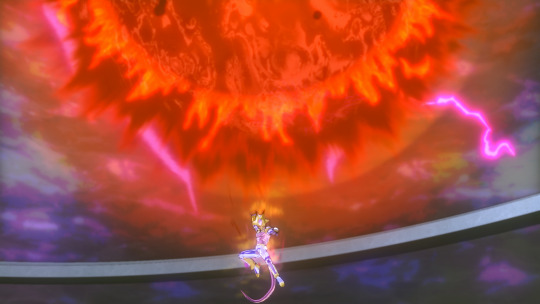
Frieza Race characters probably gained the most in the sequel. Their Awoken Skill, Turn Golden, is relatively straightforward, both from a gameplay standpoint and an aesthetic standpoint. Your ki blasts are stronger and you do the Golden Frieza thing. Much like the form in the series proper, it's a bit dull and uninspired as a body recolor, but it is identifiable as a powerful transformation.

Namekians gained the ability to Become Giant, hearkening back to King Piccolo in the original Dragon Ball (and I guess Lord Slug in the movies), which as I understand was a fun transformation to use before it got nerfed in subsequent patches. Currently, it's a neat gimmick that's fun to mess around with and can be effective in bursts, but the stamina drain means it can't see the extended use that just about every other Awoken Skill can.

Majin gained the wildly unpopular ability to undergo Purification, which translates into becoming a Kid Buu with a special moveset. A Kid Buu that, mind you, only changes its skin and eye color as appropriate; regardless of how you customized your character before the transformation, your Purified Majin is going to look basically the same as any other Purified Majin, which is kind of a problem in a game where a significant portion of the userbase's interest in the game is at least partially in coordinating outfits for their player characters.
Earthlings got to ride on a Flying Nimbus and use the Power Pole.

The race-specific Awoken Skill for Earthlings is riding around on a cloud that kinda already loses a lot of its luster when, by construction, all characters can fly, and wielding a weapon/tool that hasn't been relevant since the original Dragon Ball. It's a nostalgia play that basically no Earthling character is going to use extensively, since you can't use your own skills and are limited to a moveset that loses its visual and gameplay novelty in minutes, at most.
It should be mentioned that Saiyans, as of the time of this writing, have access to five variants of Super Saiyan.

(Caveat that I can't speak for the PvP side of these evaluations, and quite frankly, I couldn't be bothered since Xenoverse PvP seems thoroughly unappealing, but I digress.)
So yet again, even when concessions are explicitly made to make playing non-Saiyan races an appealing alternative from a gameplay standpoint, Saiyans are still the clear winners and Earthlings are still clear losers. Furthermore, there's at least an argument that the non-Earthling Awoken Skills at least invoke an image of power as understood in Dragon Ball. For all the shortcomings of the Namekian and Majin Awoken Skills, you can at least point to King Piccolo and Kid Buu as signifiers of strength. If anything, the image of Goku on the Nimbus with the Power Pole is reminiscent of a time when Dragon Ball was significantly less concerned with displays of power, which is kind of counterintuitive when it's invoked as a method of attaining greater power.
Put reductively, it's kind of a bummer, but then again, isn’t this dynamic, of Saiyans being given the lion's share of power and relevance while Earthlings get virtually none, the most Dragon Ball shit ever?

Hindsight has only made Videl's presence in the early parts of the Buu Saga all the more fascinating. For that run of episodes, all the way up to the World Martial Arts Tournament, the degree to which Videl is an active participant and outright combatant in the action is kind of surreal. It's not entirely without precedent, since Chi-Chi had her moments in the original Dragon Ball and the occasional moment in Z, but unlike Chi-Chi, it really does seem like Videl's perfectly content to be this active for as long as she's around. What's more, the show explicitly makes reference to her being wildly more powerful than her dad, who himself is established as of legitimate world champion caliber, and it even goes out of its way to have Gohan teach her to fly. While that scene is absolutely primarily meant to set up her true purpose in the series writ large, there's a pretty good correlation in Dragon Ball between "people who can fly" and "people who can at least fight a little".
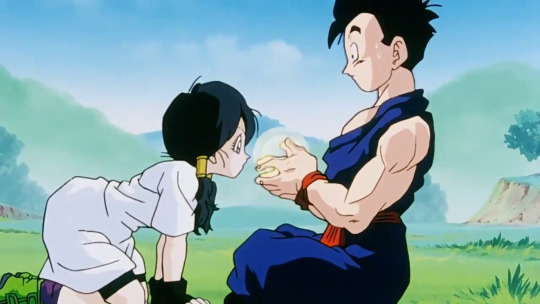
Then, of course, Spopovich happens.

I'm not particularly interested in litigating post-crisis Videl here, since it's been discussed plenty, and yeah, I also think it's more than a little bit of a bummer. But knowing the trajectory of post-Z Dragon Ball, especially Super, it makes Videl's irrelevance on an action level kind of an inevitability? Like, yeah, maybe if she bounced back harder and played a larger role after the Spopovich fight, you maaaaaaaaaaaaaaybe could draw a line to her at least being comparable to the likes of Krillin, Tien, and Yamcha, but given the reality of modern Dragon Ball, would that be anything more than a pyrrhic victory?
So really, when you consider that the frankly ridiculous power scaling of Super is really just the logical extension of the scaling in Z that was already well underway by the Buu Saga, it naturally raises the question of why they bothered to even make Videl this much of an active force in the first place. From square one, she's arguably destined to be relegated to Gohan's love interest and future wife, so why go through the effort of showing the audience that she's stronger than every Earthling that's not a Z-Fighter? It does parallel Chi-Chi's strength in Dragon Ball to help further foreshadow her pairing with Gohan like Chi-Chi with Goku, but then why make her be that into fighting when Chi-Chi was always clearly content to be a housewife?
And like, Jesus Christ, all that only to be that definitive with that Spopovich fight?
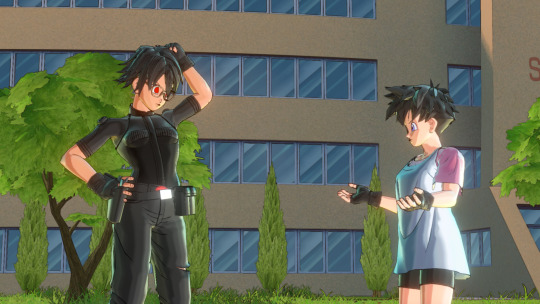
I bring Videl up because my main created character in Xenoverse 2 is a female Earthling. Ever since I booted the game for the first time, there was no doubt in my mind that I was going to primarily play as a female Earthling, because with it came the knowledge that I was going to control a female Earthling doing and achieving some frankly wild shit, like going toe-to-toe with Final Form Mira, literal deities, Jiren, and Ultra Instinct Goku(?!?), sometimes back-to-back in certain Parallel Quests.
And of course I can, because that is the entire reason for the Xenoverse games' existence. The game has always been an unabashed power fantasy all about defeating some of the most powerful entities in Dragon Ball history with your own created character on your own terms.
And yet, as I do all of this with my female Earthling, the knowledge that in canon, the most powerful analogue to my character is Videl, a character who almost literally gets the relevance beaten out of her in a brutal and unforgettable manner, makes the experience feel almost rebellious. It feels like everything from the godawful Awoken Skill to the subpar race/gender stat distribution for a strike-oriented build to the very nature and history of Dragon Ball itself is working against my character becoming a ludicrously powerful force of nature, and yet I not only can, but literally must push through and go even further beyond.

I cannot emphasize enough that this sense of transgression has no basis at all when it comes to the game. Absolutely nothing about the Xenoverse games explicitly suggests that Earthlings, female or otherwise, are somehow destined to be strictly lesser than Saiyans or any other races. Again, the game is an unabashed power fantasy; it's going to let you achieve that power fantasy regardless of race or gender, because to do so otherwise is completely antithetical to the entire reason people play the game in the first place.
But looking at past Dragon Ball games, at least to me, makes clear that they really didn't have to include the option to play as an Earthling. They clearly feel no obligation to do so, since they've excluded it in previous games. They completely dodge the need to include a human-like race option with the existence of Saiyans, who aren't even differentiated by the presence of a tail. I genuinely don't think any significant number of people would have even batted an eye over the exclusion of Earthlings. ‘Cause, you know, it's Dragon Ball, why would you play as an Earthling?



But they did. They let you choose to play as an Earthling, a race that Dragon Ball has essentially been drilling into your head, for years, is a strictly less powerful and less interesting version of Saiyans with practically no upside. They gave you the option, and I took it, all because it effectively let me play out an extended Videl what-if by proxy and stretch credibility into complete, unrecognizable nonsense.
I recognize that this absolutely reflects more on me and my relationship with Dragon Ball as a whole than it does on Xenoverse, but when it’s the only Dragon Ball game that embraces customizable characters to the extent that it does, it’s necessarily going to be the only game that actually lets me grapple with that tension between the source and the spin-off, and reckon with how that can shape the audience’s experience and perception of the bigger picture.
#dragon ball xenoverse#dragon ball xenoverse 2#xenoverse#xenoverse 2#dbxv#dbxv2#xv2#dragon ball#dragon ball z#dbz#videl#videl satan
83 notes
·
View notes
Text
. . .
Been playing Code Vein a lot lately... and it's been opening up my ego and Dark Sides a lot. I didn't get to express my OC creativity in the past, but now that I have done so to an extent, there's just a lot there in this game that is both interesting and unsettling.
Years prior, I watched the Underworld film series by Len Wiseman, Kevin Grevioux, and Danny McBride... and while I won't say there are parallels, I will say part of my creativity stems from that side of Vampire Storytelling.
Code Vein is a lighter, kinder side to the idea of Revenant Vampires, and really it's a different kind of expression than you would normally consider.
A closed-off society, powerless starving (and levied) Revenants whose only power is to suffer with immortality, and yet still is the fearsome, gruesome, monstrous side of their power involving Blood Codes and Blood Veils, which aid in their fighting capabilities and transform them in to mechanical beasts who feast on those who lost themselves and transformed in to even greater beasts.
And the very people who transformed their Nightmarish world in to what it is are their gaol-ers (jailers). Even if victory is achieved, it is very fleeting and pyrrhic... and the ones burdened with the greatest powers are transformed in to something greater than human and are never the same from what they once were.
And if it weren't for those who wish to push themselves to greater heights (and lesser sense of humanity), then those who still resembled being human would never get a chance to live their lives.
As if every aspect of being a Revenant was nothing but a curse... this story burrows deep in to the spine and chest cavity of the human condition, like an evil parasite.
The story functions as a Betrayal and attempt at Murder, further leading in to Slavery and Abuse, and then of course is the sense of isolation one gets by WEARING A MASK that is both protection and a very piece of one's self.
A mask containing one's own blood that is filtered through a device meant to stave off a miasma meant to drive all Revenants mad with bloodlust.
Even so much as a wiff of the miasma would drive anyone to frenzy, even if they just drank their daily ration of Blood Beads.
That Mask contains and isolates the people with exception to the scant few shelters that exist in the ruined and bored-out world they now live in, kindness and neighborly actions being few and far between.
Fear of Starvation, Fear of Domination, Fear of Monsters, Fear of the next Corner containing an Ambush. Fear of the Distorted, Fear of Corpses that aren't actually Dead, Fear of the Crumbling and Malfested world that has now taken shape through the very blood that now devours and permeates everything.
Rivers and Fountains of Blood, and those dark twisted beings that feast upon it... a dank, dark, rotten smell that only further invites hunger.
To live the "life" of a Monster that was once Human... to become the Darkness itself and conquer it... That is what Code Vein (the Game) is about.
And I deeply enjoy it.
5 notes
·
View notes